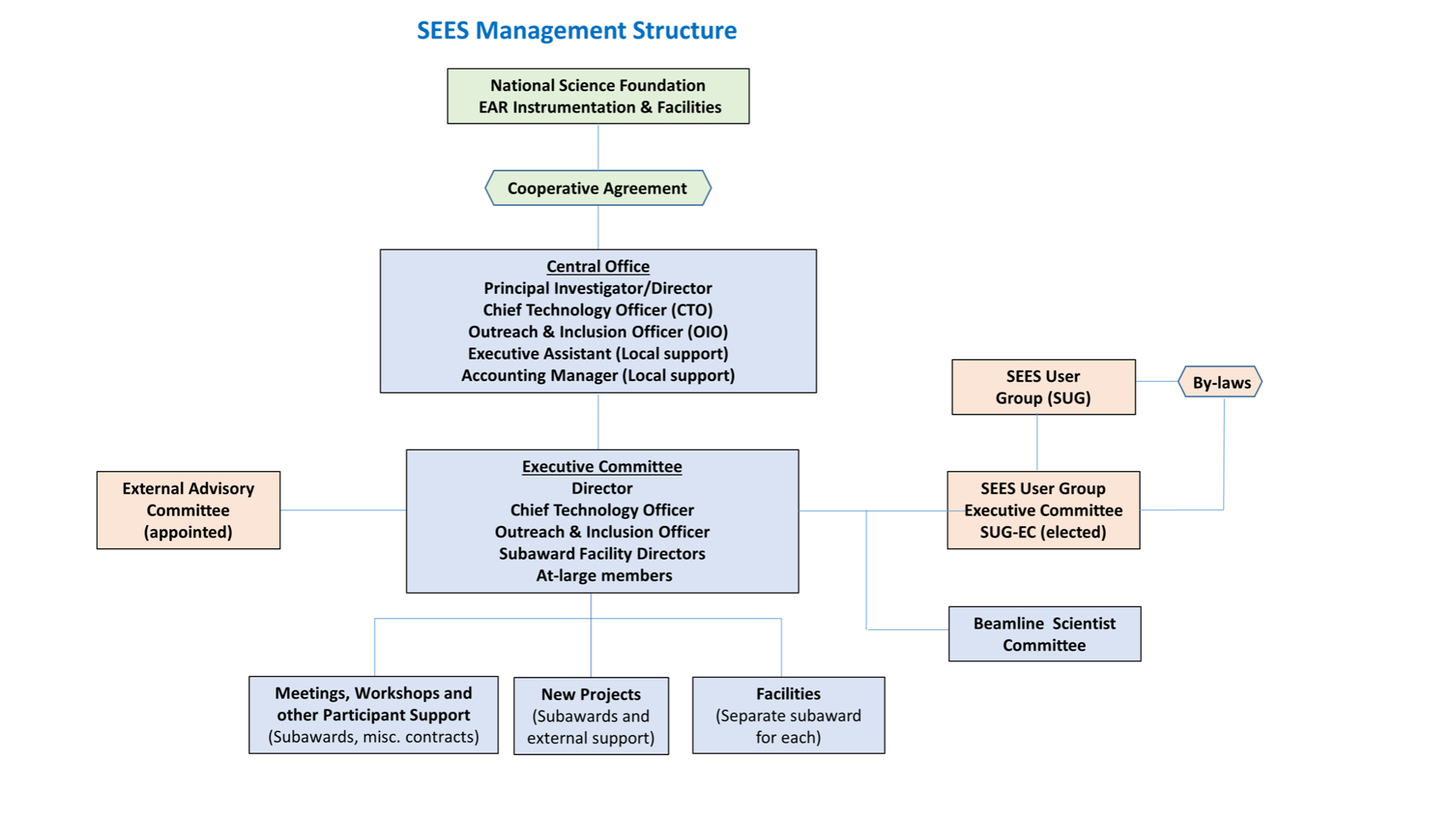Professor Andrew Campbell of the University of Chicago is the PI and Director of SEES, and has overall responsibility for the management and budget of SEES. As director, Professor Campbell will also define scientific directions and develop plans for new capabilities in coordination with the Executive Committee and with input from the EES community.
The Director is assisted by a Chief Technology Officer (CTO) and an Outreach & Inclusion Officer (OIO). The CTO (a 0.5 FTE position) will be Mark Rivers of the University of Chicago, who is responsible for overseeing the operation of all the facilities, including strategic planning, technical activities, beamline maintenance, and upgrades. The CTO will coordinate beamline operations across facilities to maximize efficiency in meeting community needs. The OIO is responsible for developing and implementing innovative educational and outreach programs with an emphasis on engagement with individuals and communities historically underrepresented in the EES

Each facility or beamline supported by SEES is managed by a Facility Director (FD). These FDs are responsible for the operation of their facility, managing SEES staff employed by or assigned to a facility, overseeing beamline operations, budgeting, and scheduling; implementing policies and procedures; and performance monitoring and measurement. The FDs interact regularly with the CTO to ensure effective beamline operations across all facilities. Scientific staff at each SEES beamline and user facility are responsible for day-to-day operation, maintenance, and development of each facility. They are involved with the user community at all stages of access from proposal submission to publication, with an emphasis on beamtime user support. The Facility Directors include the following subaward PIs and Senior Personnel:
- Joanne Stubbs, The University of Chicago (GSECARS)
- Russell Hemley, University of Illinois, Chicago
- Donald Weidner, Stony Brook University
- Brandy Toner, University of Minnesota
- Quentin Williams, University of California, Santa Cruze
- Scott Fendorf and Sam Webb, Stanford University, SSLR
The SEES Executive Committee (EC) consists of the Director, CTO, OIO, FDs, and others including representatives from the user community. The EC meets on a regular basis and advises the Director on all aspects of facility and program management, developing policies and procedures for the organization, and ensuring uniform and high-quality practices and standards across
facilities. The EC and the Director will regularly assess the professional development of the beamline
scientists and other SEES staff, and make recommendations to promote this development.
The SEES beamline scientists meet regularly to share developing practices, identify areas of mutual concern to be addressed, and communicate beamline activities with one another. The Beamline Scientist Committee will provide input to the Executive Committee and other SEES officers on development needs for the beamlines and for the scientists.
The SEES User Group (SUG) will be composed of scientists and students who conduct or collaborate on experiments at SEES facilities and/or have an interest in EES research using light sources or related user facilities. The SEES User Group Executive Committee (SUG-EC) will be elected from the membership of the SUG. The SUG-EC will be an independent body charged with providing objective advice and recommendations to the SEES management concerning all issues affecting the user community. It will serve as the official voice of the user community. The SUG-EC will be charged with seeking to identify the interests and needs of the users and advocate for those needs with SEES and facility management and elsewhere. The SEES User Group Executive Committee will also assist in developing scientific directions for the organization and will be charged with organizing the program of an annual or biennial meeting. A set of by-laws will be developed that define the membership, responsibilities, and structure of the SEES User Group and its Executive Committee. This will include specifying criteria for membership; qualifications, term of service, and selection procedures for the executive committee; committee and subcommittee duties; and mechanisms for adopting and amending the by-laws.
An External Advisory Committee (EAC) will be appointed as an additional oversight body formed ensure that SEES is achieving its scientific mission. The EAC will provide input and guidance to the Director and the EC on SEES scientific directions, strategic planning, synchrotron beamline developments, user satisfaction, and education and broader impacts. EAC members will be selected to cover a range of scientific, education and technical expertise.
A SEES science plan will be produced every five years. The Science Plan will outline the organization’s scientific achievements and future opportunities and priorities. A Science Planning Committee (SPC) will be formed with input from the Director, SEC, and SUG-EC. The SPC will solicit broad input into the science plan from the user community and facility staff through a workshop or other means. The Science Plan will evaluate the achievements of SEES, identify key science questions and problems to be addressed in the forthcoming years, and identify research priorities, facilities developments, and possible organizational strategy to address the identified science questions and needs.
There are several key metrics that will be tracked and evaluated each year to assess the performance of the Central Office, facilities, and education, outreach, diversity and community activities. Each facility and program will track metrics documenting the quantity of usage (user schedule, beamline oversubscription factors, user demographics, etc.), the quality of usage (user feedback forms, community surveys, input from user group Ex Comm), the impact of usage (facility publications and citations, student theses, and science highlights), and broader impacts (education and outreach, workforce development, engagement and partnerships with other organizations, and service to other beamlines and communities). These will be compiled and integrated with central office activities and used for self- and independent evaluation by the SUG and EAC. The Annual Report of the Director will specifically review and assess the organization based on these performance metrics.
